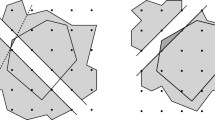Abstract
Given an n-dimensional integer vector \(\mathbf {v} = (v_1, v_2, \ldots , v_n)\) with \(v_1 \le v_2 \le \cdots \le v_n\), a pinwheel schedule for \(\mathbf {v}\) is an infinite symbol sequence \(S_1 S_2 S_3 \cdots\), which satisfies that \(S_j \in \{ 1, 2, \ldots , n \}, \forall j \in \mathbb {Z}^{+}\) and every \(i \in \{ 1, 2, \ldots , n \}\) occurs at least once in every \(v_i\) consecutive symbols \(S_{j + 1} S_{j + 2} \cdots S_{j + v_i}, \forall j \in \mathbb {Z}^{+} \cup \{ 0 \}\). If \(\mathbf {v}\) has a pinwheel schedule then \(\mathbf {v}\) is called (pinwheel) schedulable. The density of \(\mathbf {v}\) is defined as \(d(\mathbf {v}) = \sum _{i = 1}^{n} \frac{1}{v_i}\). Chan and Chin (Algorithmica 9(5):425–462, 1993) made a conjecture that every vector \(\mathbf {v}\) with \(d(\mathbf {v}) \le \frac{5}{6}\) is schedulable. In this paper, we check the conjecture from the perspective of low-dimensional vectors, including 3-, 4- and 5-dimensional ones. We first find some simple but important properties of schedulable vectors, and then propose two comparing rules according to these properties. Also, we define a vector-space tree to represent all k-dimensional vectors, for any given integer \(k \ge 2\). Under the framework of the vector-space tree, we use the comparing rules to develop a Branch-and-Cut Approach to examining the schedulability of all k-dimensional vectors. As a result, we prove that the maximum density guarantee for the pinwheel schedulability of low-dimensional vectors is \(\frac{5}{6}\), which partially supports Chan and Chin’s conjecture.








Similar content being viewed by others
References
Baruah S, Bestavros A (1997) Pinwheel scheduling for fault-tolerant broadcast disks in real-time database systems. In: Proc. ICDE’97, pp 543–551
Baruah SK, Lin SS (1998) Pfair scheduling of generalized pinwheel task systems. IEEE Trans Comput 47(7):812–816
Chan MY, Chin F (1992) General schedulers for the pinwheel problem based on double-integer reduction. IEEE Trans Comput 41(6):755–768
Chan MY, Chin F (1993) Schedulers for larger classes of pinwheel instances. Algorithmica 9(5):425–462
Dhall SK, Liu CL (1978) On a real-time scheduling problem. Oper Res 26(1):127–140
Ding W (2019) Low-dimensional vectors with density bounded by 5/6 are pinwheel schedulable. In: Proc 13th AAIM, pp. 51–61
Fishburn PC, Lagarias JC (2002) Pinwheel scheduling: achievable densities. Algorithmica 34(1):14–38
Han CC, Lin KJ (1992) Scheduling Distance-Constrained Real-Time Tasks. In: Proc. Real-Time Systems Symposium, 300–308
Holte R, Rosier L, Tulchinsky I, Varvel D (1992) Pinwheel scheduling with two distinct numbers. Theor Comput Sci 100(1):105–135
Holte R, Mok A, Rosier L, Tulchinsky I, Varvel D (1989) The pinwheel: a real-time scheduling problem. In Proc. 22nd Hawaii international conference on system science, pp 693–702
Lin SS, Lin KJ (1997) A pinwheel scheduler for three distinct numbers with a tight schedulability bound. Algorithmica 19(4):411–426
Liu CL, Layland JW (1973) Scheduling algorithms for multiprogramming in a hard real-time environment. J ACM 20(1):46–61
Romer TH, Rosier LE (1997) An algorithm reminiscent of Euclidean-gcd for computing a function related to pinwheel scheduling. Algorithmica 17:1–10
Author information
Authors and Affiliations
Corresponding author
Additional information
Publisher's Note
Springer Nature remains neutral with regard to jurisdictional claims in published maps and institutional affiliations.
A preliminary version of this paper appeared in the Proceedings of the 13th International Conference on Algorithmic Aspects of Information and Management (AAIM’19) Ding (2019).
Rights and permissions
About this article
Cite this article
Ding, W. A branch-and-cut approach to examining the maximum density guarantee for pinwheel schedulability of low-dimensional vectors. Real-Time Syst 56, 293–314 (2020). https://doi.org/10.1007/s11241-020-09349-w
Published:
Issue Date:
DOI: https://doi.org/10.1007/s11241-020-09349-w




